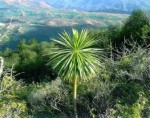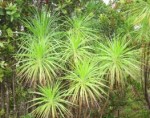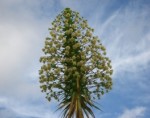Scientific Name: Wilkesia gymnoxiphium
Also Known As: Kaua’i Greensword
Endemic: Kaua’i Only
Description: Erect, normally unbranched rosette shrubs 3-10 ft. tall with long, narrow, green leaves and slightly fragrant, cream colored flowers arranged in heads of 40-350 on a stalk that protrudes above the whole plant. Towards the evening, this plant (not the flowers) is known to give off a slight, but pleasant scent, closely resembling that of a white ginger flower. Undeniably, one of the most intriguingly exotic looking plants native to Hawaii. It should be said that this plant is related to the silverswords (read the info. below) and just like those plants, these plants take at least 7 years to flower and once they do….. they die. But, the bloom is definitely worth the wait and the eventual outcome.
Distribution: This rare plant is endemic to the dry-mesic forests of Waimea Canyon on the island of Kaua’i and nowhere else in the world. Another, even more rare species called W. hobdyi is also found on Kaua’i but it has a smaller stature, slightly broader leaves and less flowering heads than this species
Landscape Uses and Care: This plant does best in full sun and dry soil, watering only 2-3 times a week for the first month and then only when needed after that. One of the biggest mistakes people do is over-water and this plant does not like to be continuously wet. It also keeps well in a pot and can be kept in a sunny location on your lanai if you choose, Very few bugs, if any, are known to bother this plant, rarely aphids or spider mites may bother it but they can be treated with a store bought pesticide or just shot off with a hose.
Additional Info: Iliau is closely related to the Silver swords of Maui and Hawai’i and is therefore a member of the “Silver sword Alliance” in which three different genera (Argyroxiphium, Dubautia and Wilkesia) comprising some 28 species were derived from a single common ancestor. This is an example of an evolutionary term called ‘Adaptive Radiation’ in which a single pioneer species rapidly evolves in to many different species that occupy various types of habitats. Our native Honeycreeper birds (Drepanidae) are also fine examples of this Hawaiian evolutionary trend
Iliau



